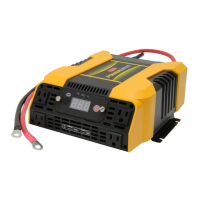Appliance Cautions
•
DO
NOT plug
in
battery chargers for cordless power tools if the charger carries
a warning that dangerous voltages are present at the battery terminals.
• Certain chargers for small nickel-cadmium or nickel-metal-hydride batteries
can be damaged if powered by this inverter.
Two
types of appliances are
susceptible to damage: Small, battery-operated appliances such as flashlights,
cordless razors and toothbrushes that plug directly into an
AC
receptacle.
• Some fans with synchronous motors may slightly increase
in
speed
(RPM)
when powered by the inverter. This
is
not harmful to the fan or to the inverter.
• Use safety approved extension cords rated at 15 Amps
or
higher.
• GFCI devices may not work with modified sine wave (MSW) power.
• This inverter
is
not tested for use with medical equipment.
• This inverter
is
not tested for use
in
marine applications.
•
In
the event of a continuous audible alarm or automatic shut down, turn the
inverter OFF immediately. Do not restart the inverter until the source of the
problem has been identified and corrected.
• When using your PowerDrive inverter to power lead acid battery chargers
(like those used for a
car,
boat or motorcycle) with modified sine wave, check
the temperature of the battery charger after 10 minutes. If the battery charger
becomes hot, immediately disconnect it from the inverter and allow it to cool
before resuming the charging operation.
Warnings: Danger of Battery Explosion - Install a Fuse
Battery Banks can deliver very high levels of current that can vaporize metal,
start fires and cause explosions. PowerDrive
TM
recommends installing one
ANL type fuse and fuse holder close to the positive battery bank terminal. This
fuse protects the batteries from accidental
DC
cable shorts, which can cause
batteries to explode. ANL fuses and fuse holders are available at most hardware
supply stores.
Cautions
• Loose connections can result
in
a severe decrease in voltage that can cause
damage to cables and insulation.
• Failure to make correct polarity (Pos/Neg) connection between the inverter
and the battery bank can result in blowing fuses
in
the inverter and can
permanently damage the inverter. Damage caused by reversed polarity is not
covered under the warranty.
• Making the connection to the Positive terminal may cause a spark as a result
of current flowing to charge capacitors within the inverter. This is a normal
occurrence.

